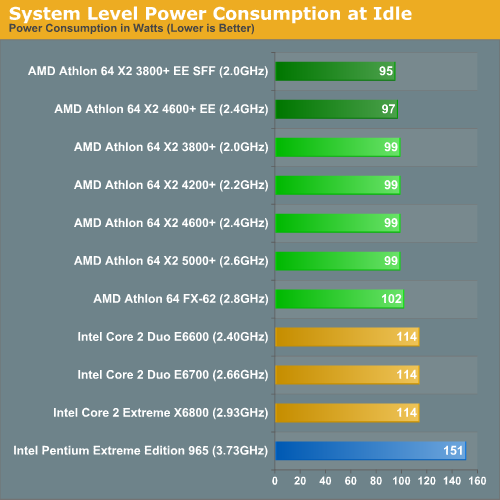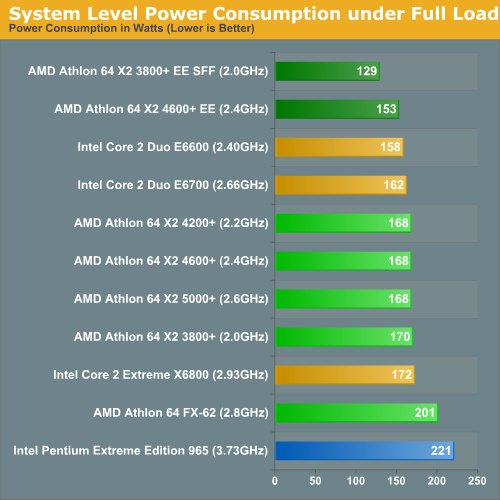Intel's Core 2 Extreme & Core 2 Duo: The Empire Strikes Back
by Anand Lal Shimpi on July 14, 2006 12:00 AM EST- Posted in
- CPUs
Power Consumption: Who is the king?
Intel promised us better performance per watt, lower energy consumed per instruction, and an overall serious reduction in power consumption with Conroe and its Core 2 line of processors. Compared to its NetBurst predecessors, the Core 2 lineup consumes significantly lower power - but what about compared to AMD?
This is one area that AMD is not standing still in, and just days before Intel's launch AMD managed to get us a couple of its long awaited Energy Efficient Athlon 64 X2 processors that are manufactured to target much lower TDPs than its other X2 processors. AMD sent us its Athlon 64 X2 4600+ Energy Efficient processor which carries a 65W TDP compared to 89W for the regular 4600+. The more interesting CPU is its Athlon 64 X2 3800+ Energy Efficient Small Form Factor CPU, which features an extremely low 35W rating. We've also included the 89W Athlon 64 X2s in this comparison, as well as the 125W Athlon 64 FX-62.
Cool 'n Quiet and EIST were enabled for AMD and Intel platforms respectively; power consumption was measured at the wall outlet. We used an ASUS M2NPV-VM for our AM2 platform and ASUS' P5W DH Deluxe for our Core 2 platform, but remember that power consumption will be higher with a SLI chipset on either platform. We used a single GeForce 7900 GTX, but since our power consumption tests were all done at the Windows desktop 3D performance/power consumption never came into play.
We took two power measurements: peak at idle and peak under load while performing our Windows Media Encoder 9 test.

Taking into consideration the fact that we were unable to compare two more similar chipsets (we will take a look back at that once retail Intel nForce 5 products hit the shelves), these power numbers heavily favor Intel. The releative power savings over the Extreme Edition 965 show just how big the jump is, and the ~15% idle power advantage our lower power AMD motherboard has over the Intel solution isn't a huge issue, especially when considering the performance advantage for the realtively small power investment.

When looking at load power, we can very clearly see that AMD is no longer the performance per watt king. While the Energy Efficient (EE) line of X2 processors is clearly very good at dropping load power (especially in the case of the 3800+), not even these chips can compete with the efficiency of the Core 2 line while encoding with WME9. The bottom line is that Intel just gets it done faster while pulling fewer watts (e.g. Performance/Watt on the X6800 is 0.3575 vs. 0.2757 on the X2 3800+ EE SFF).
In fact, in a complete turn around from what we've seen in the past, the highest end Core 2 processor is actually the most efficient (performance per Watt) processor in the lineup for WME9. This time, those who take the plunge on a high priced processor will not be stuck with brute force and a huge electric bill.










202 Comments
View All Comments
Kougar - Friday, July 14, 2006 - link
I wasn't sure of the B2 Stepping 6 info because it has been impossible to find CPU-Z shots of this chip, let alone anyone reviewing them!!Mostly I just want to ensure Intel doesn't pull any surprises or OC limiting with them, at this point if the B2 Stepping 6 with that last round of bugfixing performs even the same as a Stepping 5 I'd be extremely happy!
redpriest_ - Friday, July 14, 2006 - link
Thanks Wesley - my Core 2 Duo Extreme X6800 is definitely a Stepping 6, Revision B2 Conroe. It has a packaging date of July 5, 2006. I have all the multipliers unlocked, and I am stuck at around 3.466 ghz using multipliers only for stability. I am running on the Intel 975X BadAxe rev 304 with the latest BIOS.I haven't tried upping the bus from there, yet - I am using 1.4 volts; default voltage isn't dual prime 95 stable at 3.466 ghz, but is at 3.2 ghz.
I haven't tried any intermediate voltages between there to test, so it's possible my Conroe is stable at 3.466 ghz at less voltage. I'll give that a try.
Kougar - Friday, July 14, 2006 - link
What motherboard is this? Have you double-checked your RAM settings and memory ratio? I'd imagine setting a 1:1 ratio, using the most relaxed timings, and slowly ramping up the FSB would get you further. And do try less voltages... ;)That's my plan anyway, DDR2-800 memory speeds on a 1:1 ratio thanks to a 400FSB, 10x multiplier... :)
Kougar - Friday, July 14, 2006 - link
Anandtech used Engineering Sample CPUs, so they would be B0 Stepping 4 or B1 Stepping 5 only. Only retail models will be B2 stepping 6...Did you change your cpu voltage any? Sounds like you didn't ;)
redpriest_ - Friday, July 14, 2006 - link
I had to - 1.4 (1.35 real) to get to 3.466, and 1.5 to 3.733.Wesley Fink - Friday, July 14, 2006 - link
Did you OC by adjusting multipliers first? We could run the X6800 at 3.46 at 13 multiplier using stock voltage, but using 315 bus times the stock 11 multiplier required a small voltage increase. The easiest OCs used higher multipliers and modest FSB increases. The E Conroes are locked, however, and can only be overclocked by increasing the FSB.redpriest_ - Friday, July 14, 2006 - link
Yes, I tried using multipliers only, I haven't fiddled with bus speed yet.Kougar - Friday, July 14, 2006 - link
First, the X6800 is selling at NewEgg, and they are price gouging it for all it's worth. Still listed in stock after having been up for 3+ hours...What a great way to start the day... Thank you Anandtech for this great article! Supurb! Now I have to agree with the poster above me, some info on the E6300 overclocking would about round out my curiosity!
I have a question though, do y'all or anyone else have some CPUZ shots of a retail shipping Conroe? I believe this are supposed to be revision B2 stepping 6??
As for the expected skeptics, my saying the numbers appear to jive won't mean anything... so I'll just say there are over 25 reviews out now of the Core 2 Duo released today. :)
mAdMaLuDaWg - Friday, July 14, 2006 - link
I'm curious on if you tried OCing the E6300. What was the highest stable speed you were able to get.xsilver - Monday, July 17, 2006 - link
for those who dont want to read the xbit labs articlethe overclocking of the e6300 is limited by the motherboard - eg. cant get the board to boot at any higher than 420mhz fsb
we may have to wait for nvidia's core2 solution to see higher fsb's